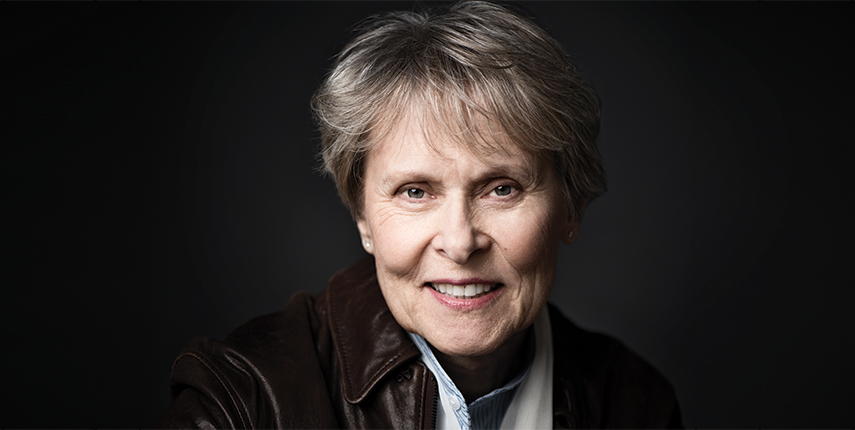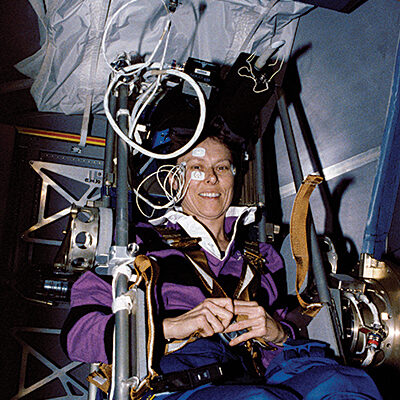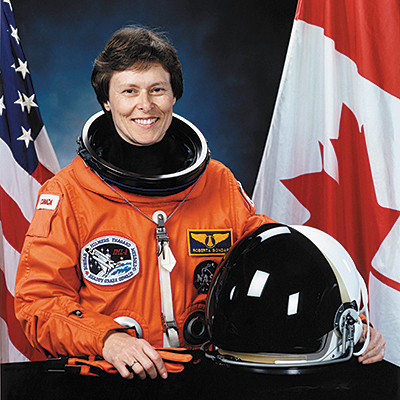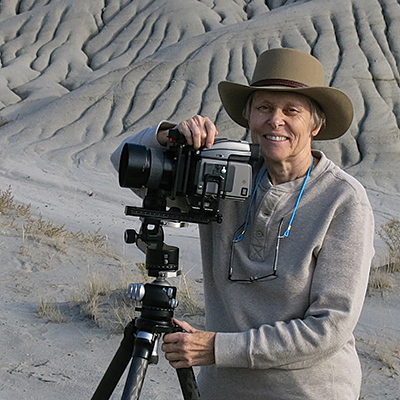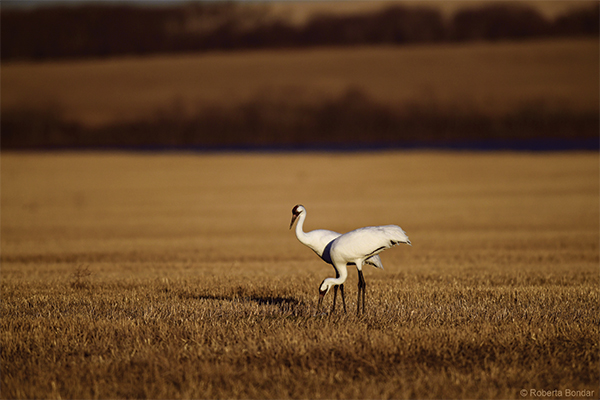View of Earth from space fuels nature photography career for U of G alum
STORY BY ANDREW VOWLES
Orbiting Earth aboard the space shuttle Discovery 30 years ago, Dr. Roberta Bondar heard the voices of her six crewmates, mechanical sounds from equipment, taped music. But as she peered through a window while photographing the planet as a member of NASA’s Earth Observation Team, it was what she couldn’t hear that struck her: no chuckling of running water, no windsighing through tree branches, no birdsong. “When I was looking at the Earth in space, I didn’t see any people,” says Bondar, B.Sc. (Agr.) ’68, whose eight-day mission in 1992 made her Canada’s first woman astronaut. “I didn’t hear any natural sounds. It left me with a sense of foreboding. I’m getting a ringside seat as if the natural world had disappeared. I didn’t like that.”
On the upside, the same vantage point fostered conviction and hope about the future of the planet – traits that would ultimately lead her to a successful post-NASA career as an acclaimed nature photographer and champion of environmental activism. Besides affording many “emotional moments” while the shuttle orbited the planet 129 times, the view of Earth suspended against the endless blackness of space brought home her U of G studies of ecology and ecosystems from decades earlier. “The idea to be able to look at Earth as a planet was one of the big values of the flight,” says Bondar, who marked the thirtieth anniversary of her Discovery mission in late January. “I got a more holistic and compassionate view of Earth as a planet and what we need to maintain our existence as a life form.”
Back on firm ground, she initially devoted herself to extending her research done aboard STS-42. As the first neurologist in space, Bondar conducted experiments in the shuttle’s International Microgravity Laboratory. For more than a decade after the flight, she headed an international research team studying connections between astronauts recovering from the microgravity of space and neurological illnesses here on Earth such as stroke and Parkinson’s disease. She had hoped to follow up on that work with a return mission to space, but that didn’t happen. Later, Bondar even considered returning to medical practice, going so far as to undertake hospital rounds. All the time, that tug of emotional gravity she’d felt aboard the shuttle had been exerting its influence. She returned to school once more, this time for training as a professional nature photographer. Today Bondar’s varied experience and expertise finds expression in her fine art photography and in her role as the public face and name of a foundation dedicated to raising awareness of the natural world. It’s been decades and several academic degrees since her undergrad days. But in several ways, her active work with the Roberta Bondar Foundation draws upon experiences and ideas that she encountered beginning in 1964 as a member of the first undergrad cohort on the campus of the newly established U of G. “The University of Guelph was the firm foothold,” says Bondar.
Raised in Sault Ste. Marie, Ont., she enrolled at the University to pursue interests in entomology sparked by her summer work experience at a forestry insect lab. Aiming to become a science and physical education teacher, she pursued a slate of science courses alongside extracurricular basketball and archery. She planned to obtain her agriculture degree and then complete a one-year physical education program at McMaster. But in her third year here, two key things happened to alter those plans.
“I got a more holistic and compassionate view of Earth as a planet and what we need to maintain our existence as a life form.”
In that year, McMaster cancelled its PE program. Perhaps more important, Bondar contracted mumps and wound up locked in a campus infirmary. The affliction caused temporary neurological damage to her right shoulder that would end her campus athletics. She recalls a nurse’s words: “You might as well resign your year because you’re not going to pass.”
One day from her isolation window, she spotted her marine biology professor passing in front of Creelman Hall. “I think I put a sign up that said: Help.” Whatever she did, she managed to attract Dr. Susan Corey’s attention. The then biology professor found work for Bondar in her lab, where she made up her missed coursework and ultimately added a zoology major to her program. As well, she pursued communications courses through the new arts college, partly so that she could explain her science studies to her family.
Years later, that mixed curriculum— and subsequent graduate studies at Western University and the University of Toronto, followed by completion of a medical degree at McMaster University—made her an ideal candidate for the space shuttle program and the Discovery flight. Her interest in space had been sparked in childhood, all the
way back to her first Brownie Hawkeye camera and the cardboard “space helmets” that arrived one day in the mail for her and her sister, Barbara. Later, as a grad student back home in the summer of the Apollo 11 moon landing in 1969, she stood with her dad in the backyard, gazing up at the moon, and said, “That’s really what I’d like to do.”
Through the 1970s, that prospect appeared unlikely. Then in 1982, partly on the strength of the Canadarm, the Canadian astronaut program began, and Bondar applied to join the inaugural cohort. Lacking engineering and extensive flight experience (although she had gained a pilot’s licence), she might not have seemed the most promising candidate. But it turned out that NASA liked her mixed background, going all the way back to her U of G studies ranging from plants to embryology. In late 1983, she was among the first six Canadian astronauts chosen. “I knew my stuff. That’s why I became the ‘right stuff,’” says Bondar, who ended up running dozens of microgravity experiments aboard Discovery. “Other contenders had other skill sets, but they weren’t necessarily what NASA needed.”
That comprehensive grounding resonates with Dr. Charlotte Yates, whose official installation earlier this year as U of G president and vicechancellor included video greetings on behalf of alumni from Bondar. “As a scientist who studied biology, zoology and agriculture before becoming a medical doctor, Dr. Bondar now uses the power of her photography to advance
environmental advocacy,” says Yates. “She is the perfect example of an interdisciplinary thinker, nurtured and supported at this very institution, who went on to impact the world with her work.” As an award-winning nature photographer, Bondar has taken her cameras across much of Canada and the United States as well as Kenya. In the field, she mixes ground-level, close-up work with photographing from aircraft, sometimes half-hanging out an open helicopter doorway to get the shot. Her photos are held in various private and public collections in Canada, the United States and Europe, and have appeared in several bestselling books, including Passionate Vision, published in 2008 and containing shots from all 41 Canadian national parks.
Among numerous awards and distinctions, Roberta Bondar is a Companion of the Order of Canada, a member of the Order of Ontario, and an inductee of the Canadian Medical Hall of Fame and the International Women’s Forum’s Hall of Fame. Formerly chancellor of Trent University, she has received honorary doctorates from almost 30 Canadian and American universities, including U of G in 1990. She is a specially elected Fellow of the Royal Society of Canada and an honorary Fellow and honorary vice-president of the Royal Canadian Geographical Society and has a star on Canada’s Walk of Fame
“I love the body of work she did in our national parks,” says Canadian photographer Edward Burtynsky, whose own large-scale depictions of humanity’s environmental impacts include the earlier well-subscribed exhibitions “Anthropocene” and “Manufactured Landscapes.” Both photographers have spoken and exhibited together at various events; recent samples of their work will be paired this year in Canada’s Senate building under a project led by Senator and art historian Patricia Bovey. Burtynsky says he and his colleague are part of a “sea change” involving various contemporary artists—writers, photographers, painters, filmmakers—whose works are increasingly drawing attention to environmental issues and concerns. In Bondar’s case, he says, her former vantage point from the space shuttle lends her extra conviction. “I think her seeing the Earth from space, that moment when a lot of astronauts come to see the Earth in powerful ways—you don’t see boundaries, countries, you see the nature, the green, the brown. She speaks about and makes photographs of that landscape under threat. It’s important for us to have respect and reverence and to understand its important role in our own survival.”
Several of Bondar’s works were part of a 2017 exhibition called “Light in the Land: The Nature of Canada” held at the Art Gallery of Guelph. Interviewed during that event, she said, “Something that I’m trying to bring to people’s attention in terms of the diversity of the country is that we have different types of biological systems. We have places that some people will never get to, and I feel that it is important for me, after my space flight, to talk to people about the very valuable piece of real estate that Canada has.”
“Our survival depends on how we treat the world around us.”
The same desire to share her vision now drives the work of the Roberta Bondar Foundation, based in Toronto. Established in 2009, the foundation aims to promote environmental conservation, respect and curiosity through science and art. Explaining the impetus for its creation, she says, “I firmly believe if you love something, you want to protect it. I see the natural world in peril because of what we do. I feel the role of my foundation, and my views since my space flight, is really to present the beauty of the world as it exists in the moment. We need to take some responsibility in trying to lessen the impact that we have as a life form on these wonderful natural systems.” For Bondar, it’s an ethical responsibility that finds expression in living more economically, including repurposing material and belongings like, say, used camera equipment. Staff at an observatory in Alberta’s Wood Buffalo National Park, for instance, are using donated equipment marked with her name. “I can’t remember the last time I sold a camera. I don’t like dumping things,” she says. “I think our survival depends on how we treat each other and how we treat the world around us. It’s the ethical nature of human beings that will dictate the survival not just of human beings but the survival of the natural world.”
Today the foundation’s programs include everything from travelling biodiversity exhibitions taken to galleries, schools and museums, to a nature photography challenge for students run in partnership with EcoSchools Canada, to a national innovation and creativity award launched early this year as part of the Discovery flight anniversary. Under a relatively new endeavour called Space for Birds, Bondar aims to draw attention to human impacts—notably hunting and habitat loss—on endangered species of migratory birds. She’s chosen seven threatened species whose migration paths between breeding
and wintering grounds collectively span much of the globe.
Nature photographer Roberta Bondar documents migratory bird species
The black-tailed godwit, for instance, wings between the Netherlands and sub-Saharan Africa, a journey of about 3,000 km, one way. Other species cover up to 15,000 km in a flight, as with the curlew sandpiper that travels from the Siberian Arctic to sub-Saharan Africa and the red knot whose journey takes it from the Canadian Arctic to southern South America. For each species, the foundation has developed online “story maps” detailing life cycles as well as hazards posed by human habitat encroachment and ideas for site visitors to help preserve the birds. The story maps feature Bondar’s ground- and aircraft-based photos along with NASA images of Earth—a range of vantage points reflected in the project’s formal name: AMASS, or Avian Migration Aerial Surface Space.
Earlier this year, Bondar spent a week at the Aransas National Wildlife Refuge on the Gulf coast of Texas. There, she photographed whooping cranes in their wintering grounds for the project— they fly 4,000 kilometres northward each year to breeding grounds at the border of Alberta and the Northwest Territories—and spoke at the Whooping Crane Festival held in Port Aransas in late February. With her were members of the foundation, including board chair Dr. Bonnie Patterson, who served as president of Trent University during Bondar’s six-year tenure as chancellor.
In her board role, Patterson might equally be speaking to visitors to the foundation booth at a trade show or slinging camera equipment on an African savannah field trip or across the Burgess Shale in the Canadian Rockies. “There’s never been a time when I have been in the field when I haven’t learned something,” says Patterson, adding that her colleague brings to her work a mix of focus, creativity, determination and patience. Humility and humanity are also important ingredients: “She can take photos and put them together for a United Nations Environment Program conference in Egypt and inspire people there about what has to happen. Then she can take those photographs to a small community, and she will be the same, helping people learn, inspiring them.”
“I’m not sure I’ve ever met a greater humanitarian,” says Bovey, the first art historian to be appointed to Canada’s Senate in 2016. Referring to Bondar, she says, “Her warmth just exudes.” Bovey, formerly the director of the Buhler Gallery at St. Boniface Hospital in Winnipeg, recalls the photographer’s visit there during an exhibition of her work in 2014. Among the visitors were a woman and her young son, both recent Spanish-speaking immigrants to Canada. “The boy came in with a children’s book about space in Spanish. Roberta sat down on the gallery floor with him. They went through the book page by page, and she gave English words for his favourite images,” says Bovey. “Here is one of Canada’s astronauts sitting on the floor in a gallery in a hospital in St. Boniface, Manitoba, taking time to talk to this little boy.”
Bondar says for any audience, it’s important to encourage people to take small steps. It’s like learning the alphabet, one letter at a time. In your neighbourhood, environmental consciousness might show up when kids start picking up litter or teach their parents to do the same. “It’s not just about taking photos but about teaching people to look at the world around them,” she says. “We know we have to do things in a manageable way. We want to get people to move along the continuum. We have to give them a place to start, we have to give them an emotional reason to do it.”
